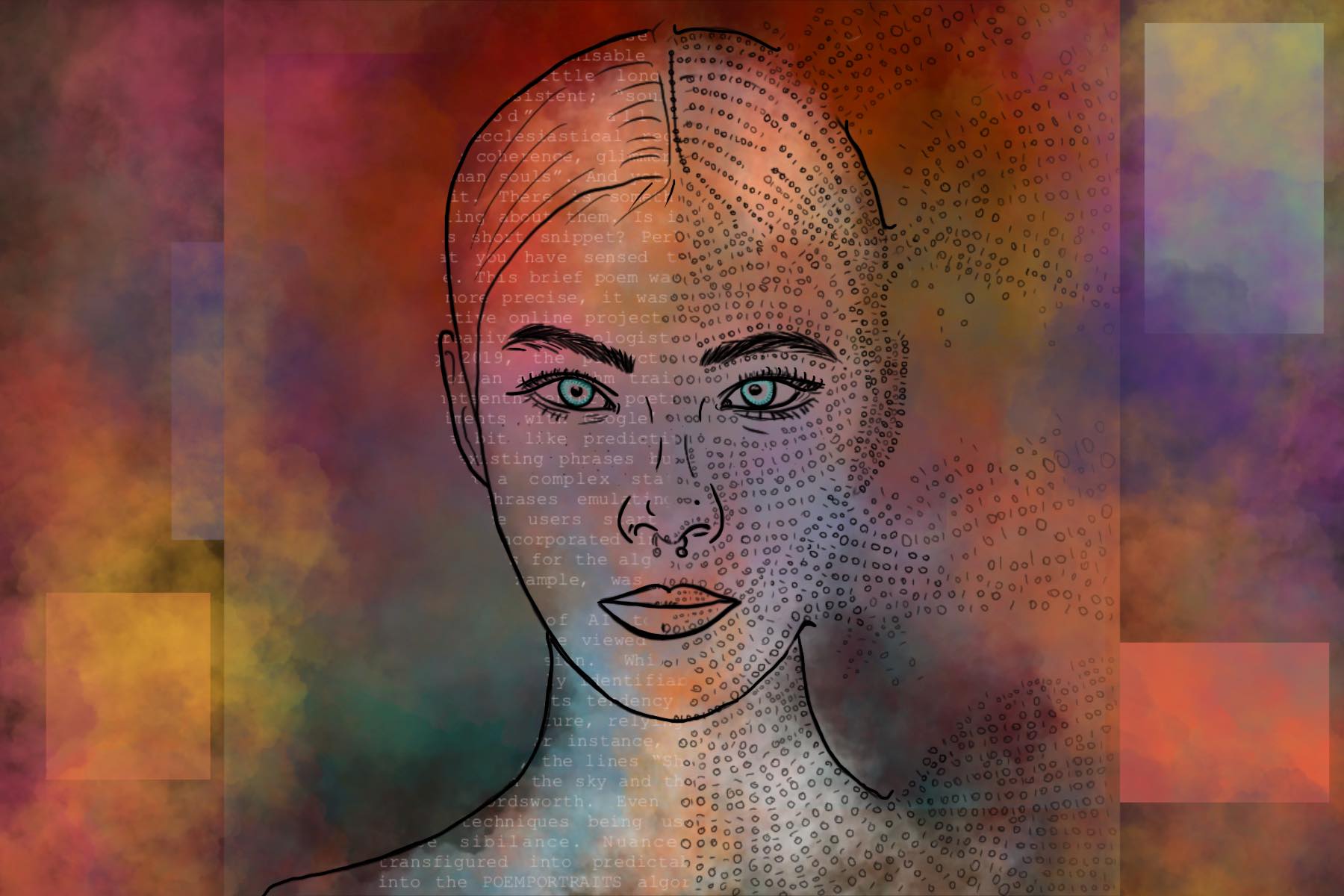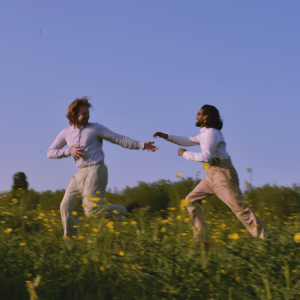
Verse ex Machina
by Liz Murphy | April 22, 2020
Our human souls have been allowed to stand alone,
Your love with spirit confirms the sunk brow of God
The lines materialise on the screen. They are, admittedly, recognisable as poetic. Then you examine them for a little longer. The wording here feels credibly consistent: “souls”, “spirit”, and “sunk brow of God” all belong to an ecclesiastical register. There is a sense of thematic coherence, glimmers of narrative: “your love”, “our human souls”. And yet, still, there’s something off about it. There is something disconcerting, something unsettling about these lines. Is it what the poet is conveying in this short snippet? Perhaps. The more likely reason is that you have sensed the underlying presence of a machine. This brief poem was written by a computer.
To be more precise, it was composed by POEMPORTRATS, an interactive online project conceived by artist Es Devlin and creative technologist Ross Goodwin. Launched in Spring 2019, the project generates original verse by means of an algorithm trained on over 25 million words of nineteenth-century poetry. The open source platform Experiments with Google writes that “[POEMPORTRAITS] works a bit like predictive text: it doesn’t copy or rework existing phrases but uses its training material to build a complex statistical model to generate original phrases, emulating the style of what it has read.” Once users start donating words, they are instantly incorporated into the poetry created, acting as a stimulus for the algorithm to respond to. The above poem, for example, was formed from the stimulus of ‘human’.
The capacity of AI to emulate poetic styles and techniques can be viewed by many as a direct threat to creative expression. In its current form, AI poetry is largely identifiable as non-human. This is in part owing to its tendency for more rudimentary ideas, words, and structure, relying on past conventions as sole inspiration. For instance, when ‘shadowy’ is donated to POEMPORTRAITS, the lines “Shadowy stream, and flowers of sleep, within the sky and the sea,” are regurgitated. Not exactly Wordsworth. Even still, there are signs of poetic techniques being used: certainly alliteration and sibilance. Nuances of poetic writing are transfigured into predictable patterns once inserted into the POEMPORTRAITS algorithm. It is likely that as AI technologies continue to advance and become more effective in appropriating the human, poetic voice, machine-generated poetry will become increasingly ambiguous.
A self-defined “experiment at the boundaries of AI and human collaboration”, POEMPORTRAITS pushes us further into the realm of human-passing cyber intelligence. As these boundaries become progressively obscured, a real risk emerges of the human voice losing its distinction. Seemingly to illustrate this point, the online game Bot or Not, pitched as “the Turing test for poetry”, asks players to decide whether an excerpt of poetry is written by a robot or a human poet. Out of curiosity I had a couple of attempts myself. I was within the forty-six percent of people who correctly identified Tao Lin’s “from 2 a.m. to 6 a.m. i ate things” as written by a human. My guess was in the minority. Evidently, the capacity of artificial intelligence to imitate the ‘human’ voice is becoming realised.
The advent of new technologies, in this case machine-generated poetry, often causes fears amongst traditional artists that they will be displaced. Creativity has long been regarded as a uniquely human trait. It was perhaps too quickly presumed that the artistic industries would be unaffected by the technological revolution, compared to the more easily automated job sectors. But the apprehension surrounding the new frontier may be a result of the reverence placed on poetry and writing in the first place. Art, in its most abstract form, is broadly regarded as requiring human intent, inspiration, a desire to express something. The concepts of art and inspiration are often spoken of in mystical terms, beyond the realm of science and technology. To now see computer-generated poetry being confused with John Keats, one of the poets featured in Bot or Not, or even robots being capable of writing poetry in POEMPORTRAITS, feels like a corruption of verse and prose. Yet, clearly, the patterns of poetic style are easily imitated by these algorithms. When considered in the context of computer programming, the poetic form itself appears more rule based. Metre, rhyme, and stanza formation all lend themselves to codification; in particular, sonnets prove to be a perfect blend of rules, literary history, and creativity. Given these similarities, maybe the leap to machine-generated poetry is not such a leap after all.
It is important to remember that AI writing is just the latest evolution of the relationship between technology and human creativity. Prior to the invention of the camera, painters were the only people who could create realistic images of the world. Fast forward to 2020, our world is so saturated with photos and images that is it hard to comprehend a situation in which realistic representation is rare. The technical skills of realism were inextricable from the production of the art, but this relationship became irrelevant with the invention of the photographic camera. Like POEMPORTRAITS and other contemporary AI-human creative collaborations, photography received backlash. “From today, painting is dead!” announced Paul Delaroche, a painter, upon attending the demonstration of one of the first primitive forms of photography in 1839. The poet Charles Baudelaire wrote in 1859: “If photography is allowed to supplement art in some of its functions, it will soon supplant or corrupt it altogether, thanks to the stupidity of the multitude which is its natural ally.” For these critics, the mechanical products of cameras cheapened ‘true art’. What Delaroche and Baudelaire failed to appreciate is that in automating the task of producing realistic images of the world, the burden of realism was lifted from painting. Liberated from these constraints, artists were free to take advantage of what painting could do that photography could not. The successive art movements of the twentieth century stand as prime examples of how technology helped push creativity forwards into daring and revolutionary realms.
So, this modern adoption of artificial intelligence into creative expression should be regarded with excitement and not fear. It should be framed as augmentation, not replacement, revealing a vast array of new opportunities for artistic endeavours. According to Ray Kurzweil, one of the leading thinkers in AI, this new creative process begins with ‘hybrid thinking’, an interplay between human and cyber intelligence for our mutual benefit. This is not isolated to traditional understandings of art; for example, public speaking is being tested as a possible area where artificial intelligence can replicate and even aid performance. The communications skills platform Quantified Communications reports that natural language processing, which translates human communication into the computer’s processing language, can conduct automated content evaluations. The AI programme uses algorithms built from years of audience perception and communication research to analyse the effectiveness of a speech, in turn improving our understanding of public speaking. This synthesis of artificial and human intelligence is already taking place in our everyday lives. If you have ever taken Google’s suggestion when responding to an email, or one of Apple’s provided options when constructing a text, you have been such a collaborator.
Some writers and creatives are already using computational systems like the POEMPORTRAITS project to test the creative frontier that ‘hybrid thinking’ presents. Ross Goodwin, a POEMPORTRAITS project collaborator, is one of the world’s leading innovators in this area. His projects rely on neural-network architecture, and computing systems modelled and named after human brain circularity. Until recently, Goodwin had confined himself to poetry and other short-form writing. But, alongside filmmaker Oscar Sharp, he has journeyed into the world of machine-generated cinema. The short film Zone Out, written and produced almost entirely independently by the AI programme Benjamin, makes clear the potential these systems have. The self-named Benjamin was initially intended to act and direct as well but owing to the AI’s lack of physical body and camera, this idea had to be scrapped. Instead, it was fed hundreds of sci-fi screenplays and entire public domain films, such as The Last Man on Earth and The Brain That Wouldn’t Die, in order to produce a script. Actors including Thomas Middleditch then performed the lines in front of a green screen for Benjamin to superimpose over scenes from the supplied films. After being given random prompts and forty-eight hours to complete the short film, Zone Out was made.
However, like in the POEMPORTRAITS poetry, there is a lingering awareness of a machine’s presence in the short film. When it was first screened at the Sci-Fi-London Film Festival, one of the jurors apparently stated, “I will give them top marks if they promise never to [make this] again.” Upon watching the film, I can see why. The incongruent AI voice that dons the flickering faces, that oscillate between the original film and the new actors, is disconcerting to say the least. Watching Zone Out proves to be an overall uncomfortable experience. Though it demonstrates an obvious capacity and ability of computers, it is uncertain whether their products could ever be accepted as films by our normal standards. They are simply too alien in their current state.
It’s fair to ask: does that matter? The notion that machine-generated poems should be expected to pass the Turing test is boring. It prohibits us from being able to push the boundaries of machine-generated writing. AI writing should be thought of as an entirely new and worthy category of art. If we stop assessing systems such as POEMPORTRAITS and Benjamin by their imitative powers, how close they get to mastering ‘humanness’, we might begin to appreciate their creative powers in a new light. This is perhaps especially relevant in the case of poetry. Many would consider it to be a declining writing form in the modern world – it certainly holds less cultural authority in the world today. AI poetry, when seen as a form of poetry in its own right, is far more interesting than a discredited emulation of previous work.
This idea of a new, distinct category of writing is continually being tested by Goodwin. In 2018, he published 1 in Road, a quintessential American road trip novel, heralded as the first to be written by a machine. The Atlantic reported on Goodwin’s writing process: “Along the way, the four sensors – the camera, the GPS, the microphone, and the computer’s internal clock – would feed data into a system of neural networks Goodwin had trained on hundreds of books and Foursquare location data, and the printer would spit out the results one letter at a time.” Inspired by Jack Kerouac’s famously mythologised in-the-moment writing style, the AI system independently generated each line as new information was processed. The finished product was reviewed in the article as providing a Google Street map perspective of the road trip. This is obviously a divergence from our typical expectations of the novel form. But using surveillance technology to write about a society increasingly dominated by that same surveillance technology introduces an interesting dimension to the narrative voice. When we consider the machine-generated novel as a new form entirely, one that accurately represents the modern narrative, the writing is ground-breaking.
Once we begin to credit artificial intelligence writing as a legitimate literary genre, the question of where authorship lies demands attention. Ascribing authorship to a computational system raises a series of conflicting definitions of where we draw the boundaries of what an author is. What concessions would we have to make to credit a piece of software as the author of an artwork? Who is the author in POEMPORTRAITS – the AI or the person who donates a word? These questions become more pressing as this writing method becomes more pervasive.
Appreciating the history of intelligent machines compels us to reassess their capabilities, as well as the value of what we fear it is replacing. A natural progression from questioning “Can a machine write poetry?” is “What is poetry?”. As we explore the ways in which these algorithmic systems write verse and scripts that seem familiar or discordant, we continue to discover what is means to be human: as writers and readers, creators and consumers. What lies ahead for writing is uncertain. Human ingenuity and creativity still play an integral role in any machine-generated writing in providing the data from which the algorithm can work off. But the responsibility of ‘writing’ is no longer exclusive. POEMPORTRAITS shows a likely possibility, that the writing of poetry, or any mode of creative expression, will soon be a product of artificial and human intelligence working in harmony. Not human, not AI, but something new altogether.∎
Words by Liz Murphy. Art by Sasha LaCômbe.




